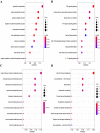Screening of ferroptosis-related genes in sepsis-induced liver failure and analysis of immune correlation
- PMID: 35923893
- PMCID: PMC9341447
- DOI: 10.7717/peerj.13757
Screening of ferroptosis-related genes in sepsis-induced liver failure and analysis of immune correlation
Abstract
Purpose: Sepsis-induced liver failure is a kind of liver injury with a high mortality, and ferroptosis plays a key role in this disease. Our research aims to screen ferroptosis-related genes in sepsis-induced liver failure as targeted therapy for patients with liver failure.
Methods: Using the limma software, we analyzed the differentially expressed genes (DEGs) in the GSE60088 dataset downloaded from the Gene Expression Omnibus (GEO) database. Clusterprofiler was applied for enrichment analysis of DEGs enrichment function. Then, the ferroptosis-related genes of the mice in the FerrDb database were crossed with DEGs. Sepsis mice model were prepared by cecal ligation and perforation (CLP). ALT and AST in the serum of mice were measured using detection kit. The pathological changes of the liver tissues in mice were observed by hematoxylin-eosin (H & E) staining. We detected the apoptosis of mice liver tissues using TUNEL. The expression of Hmox1, Epas1, Sirt1, Slc3a2, Jun, Plin2 and Zfp36 were detected by qRT-PCR.
Results: DEGs analysis showed 136 up-regulated and 45 down-regulated DEGs. Meanwhile, we found that the up-regulated DEGs were enriched in pathways including the cytokine biosynthesis process while the down-regulated DEGs were enriched in pathways such as organic hydroxy compound metabolic process. In this study, seven genes (Hmox1, Epas1, Sirt1, Slc3a2, Jun, Plin2 and Zfp36) were obtained through the intersection of FerrDb database and DEGs. However, immune infiltration analysis revealed that ferroptosis-related genes may promote the development of liver failure through B cells and natural killer (NK) cells. Finally, it was confirmed by the construction of septic liver failure mice model that ferroptosis-related genes of Hmox1, Slc3a2, Jun and Zfp36 were significantly correlated with liver failure and were highly expressed.
Conclusion: The identification of ferroptosis-related genes Hmox1, Slc3a2, Jun and Zfp36 in the present study contribute to our understanding of the molecular mechanism of sepsis-induced liver failure, and provide candidate targets for the diagnosis and treatment of the disease.
Keywords: Animal experimental verification; Ferroptosis-related gene; Immunoassay; Liver failure; Sepsis.
©2022 Chen et al.
Conflict of interest statement
The authors declare there are no competing interests.
Figures






Similar articles
-
Expression and diagnostic values of ferroptosis-related genes in coronavirus-associated viral sepsis.Front Med (Lausanne). 2025 Apr 30;12:1496834. doi: 10.3389/fmed.2025.1496834. eCollection 2025. Front Med (Lausanne). 2025. PMID: 40370730 Free PMC article.
-
Screening of potential key ferroptosis-related genes in sepsis.PeerJ. 2022 Sep 13;10:e13983. doi: 10.7717/peerj.13983. eCollection 2022. PeerJ. 2022. PMID: 36117534 Free PMC article.
-
Identification of ferroptosis-related genes in male mice with sepsis-induced acute lung injury based on transcriptome sequencing.BMC Pulm Med. 2023 Apr 20;23(1):133. doi: 10.1186/s12890-023-02361-3. BMC Pulm Med. 2023. PMID: 37081490 Free PMC article.
-
[Bioinformatics analysis and key gene verification of sepsis myocardial macrophage microarray data based on GEO database].Zhonghua Xin Xue Guan Bing Za Zhi. 2023 Jul 24;51(7):759-768. doi: 10.3760/cma.j.cn112148-20230522-00295. Zhonghua Xin Xue Guan Bing Za Zhi. 2023. PMID: 37460430 Chinese.
-
A Systematic Review of Gene Expression Studies in Critically Ill Patients with Sepsis and Community-Acquired Pneumonia.Biomedicines. 2023 Oct 11;11(10):2755. doi: 10.3390/biomedicines11102755. Biomedicines. 2023. PMID: 37893128 Free PMC article. Review.
Cited by
-
Ferroptosis in hepatocellular carcinoma, from mechanism to effect.Front Oncol. 2024 Mar 5;14:1350011. doi: 10.3389/fonc.2024.1350011. eCollection 2024. Front Oncol. 2024. PMID: 38511140 Free PMC article. Review.
-
A critical appraisal of ferroptosis in Alzheimer's and Parkinson's disease: new insights into emerging mechanisms and therapeutic targets.Front Pharmacol. 2024 Jul 8;15:1390798. doi: 10.3389/fphar.2024.1390798. eCollection 2024. Front Pharmacol. 2024. PMID: 39040474 Free PMC article. Review.
-
Time of day-dependent alterations of ferroptosis in LPS-induced myocardial injury via Bmal-1/AKT/ Nrf2 in rat and H9c2 cell.Heliyon. 2024 Aug 31;10(17):e37088. doi: 10.1016/j.heliyon.2024.e37088. eCollection 2024 Sep 15. Heliyon. 2024. PMID: 39296207 Free PMC article.
-
[Research progress on ferroptosis regulation in tumor immunity of hepatocellular carcinoma].Zhejiang Da Xue Xue Bao Yi Xue Ban. 2024 Dec 25;53(6):715-725. doi: 10.3724/zdxbyxb-2024-0117. Zhejiang Da Xue Xue Bao Yi Xue Ban. 2024. PMID: 39694527 Free PMC article. Review. Chinese.
-
Iron as a therapeutic target in chronic liver disease.World J Gastroenterol. 2023 Jan 28;29(4):616-655. doi: 10.3748/wjg.v29.i4.616. World J Gastroenterol. 2023. PMID: 36742167 Free PMC article. Review.
References
-
- Chen W, Chen M, Zhao Z, Weng Q, Song J, Fang S, Wu X, Wang H, Zhang D, Yang W, Wang Z, Xu M, Ji J. ZFP36 binds with PRC1 to inhibit tumor growth and increase 5-Fu chemosensitivity of hepatocellular carcinoma. Frontiers in Molecular Biosciences. 2020;7:126. doi: 10.3389/fmolb.2020.00126. - DOI - PMC - PubMed
Publication types
MeSH terms
Substances
LinkOut - more resources
Full Text Sources
Medical
Research Materials
Miscellaneous

